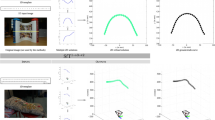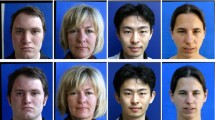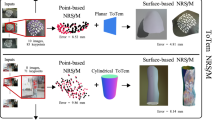Abstract
Non-rigid 3D shape recovery is an inherently ambiguous problem. Given a specific rigid motion, different non-rigid shapes can be found that fit the measurements. To solve this ambiguity prior knowledge on the shape and motion should be used to constrain the solution. This paper is based on the observation that often not all the points on a moving and deforming surface such as a human face are undergoing non-rigid motion. Some of the points are frequently on rigid parts of the structure – for instance the nose – while others lie on deformable areas. First we develop a segmentation algorithm to separate rigid and non-rigid motion. Once this segmentation is available, the rigid points can be used to estimate the overall rigid motion and to constrain the underlying mean shape. We propose two reconstruction algorithms and show that improved reconstructions can be obtained when the priors on the shape are used on synthetic and real data.
Preview
Unable to display preview. Download preview PDF.
Similar content being viewed by others
References
Aanæs, H., Kahl, F.: Estimation of deformable structure and motion. In: Workshop on Vision and Modelling of Dynamic Scenes, ECCV 2002, Copenhagen, Denmark (2002)
Brand, M.: Morphable models from video. In: Proc. IEEE Conference on Computer Vision and Pattern Recognition, Kauai, Hawaii (December 2001)
Bregler, C., Hertzmann, A., Biermann, H.: Recovering non-rigid 3d shape from image streams. In: Proc. IEEE Conference on Computer Vision and Pattern Recognition, Hilton Head, South Carolina, pp. 690–696 (June 2000)
Del Bue, A., Smeraldi, F., Agapito, L.: Non-rigid structure from motion using non-parametric tracking and non-linear optimization. In: Proceedings of the 2004 Conference on Computer Vision and Pattern Recognition Workshop (CVPRW 2004), Washington, DC, USA, vol. 1 (2004)
Golub, G.H., Van Loan, C.F.: Matrix Computation, 2nd edn. John Hopkins University Press, Baltimore (1991)
Hansen, P.C.: Regularization, gsvd and truncated gsvd. BIT 29(3), 491–504 (1989)
Jain, A.K., Zongker, D.: Feature selection: Evaluation, application, and small sample performace. IEEE Transactions on Pattern Analysis and Machine Intelligence 19(2), 153–158 (1997)
Kim, T., Hong. K.-S.: Estimating approximate shape and motion of deformable objects with a monocular view. In: Proc. Asian Conference on Computer Vision, Jeju Island, Korea (January 2004)
Kittler, J.: Feature selection and extraction. In: Young, T.Y., Fu, K.S. (eds.) HPRIP, Orlando, FL, pp. 59–83. Academic Press, London (1986)
Roy-Chowdhury, A.: A measure of deformability of shapes with applications to human motion analysis. In: IEEE Conference in Computer Vision and Pattern Recognition, vol. 1, pp. 398–404 (June 2005)
Sugaya, Y., Kanatani, K.: Multi-stage optimization for multi-body motion segmentation. IEICE Transactions on Information and Systems E87-D(7), 1935–1942 (2004)
Tomasi, C., Kanade, T.: Shape and motion from image streams under orthography: A factorization approach. International Journal in Computer Vision 9(2), 137–154 (1992)
Torresani, L., Yang, D., Alexander, E., Bregler, C.: Tracking and modeling non-rigid objects with rank constraints. In: Proc. IEEE Conference on Computer Vision and Pattern Recognition, Kauai, Hawaii (2001)
Torresani, L., Hertzmann, A.: Automatic non-rigid 3d modeling from video. In: Proc. 8th European Conference on Computer Vision, Prague, Czech Republic, pp. 299–312 (May 2004)
Torresani, L., Hertzmann, A., Bregler, C.: Learning non-rigid 3d shape from 2d motion. In: Thrun, S., Saul, L., Schölkopf, B. (eds.) Advances in Neural Information Processing Systems, vol. 16, MIT Press, Cambridge (2004)
Vidal, R., Hartley, R.: Motion segmentation with missing data using powerfactorization and gpca. In: IEEE Conference on Computer Vision and Pattern Recognition, Washington D.C., vol. 2, pp. 310–316 (June 2004)
Xiao, J., Chai, J., Kanade, T.: A closed-form solution to non-rigid shape and motion recovery. In: Proc. 8th European Conference on Computer Vision, Prague, Czech Republic (May 2004)
Yezzi, A.J., Soatto, S.: Deformotion: Deforming motion, shape average and the joint registration and approximation of structures in images. International Journal of Computer Vision 53(2), 153–167 (2003)
Author information
Authors and Affiliations
Editor information
Editors and Affiliations
Rights and permissions
Copyright information
© 2005 Springer-Verlag Berlin Heidelberg
About this paper
Cite this paper
Del Bue, A., Lladó, X., Agapito, L. (2005). Non-rigid Face Modelling Using Shape Priors. In: Zhao, W., Gong, S., Tang, X. (eds) Analysis and Modelling of Faces and Gestures. AMFG 2005. Lecture Notes in Computer Science, vol 3723. Springer, Berlin, Heidelberg. https://doi.org/10.1007/11564386_9
Download citation
DOI: https://doi.org/10.1007/11564386_9
Publisher Name: Springer, Berlin, Heidelberg
Print ISBN: 978-3-540-29229-6
Online ISBN: 978-3-540-32074-6
eBook Packages: Computer ScienceComputer Science (R0)




